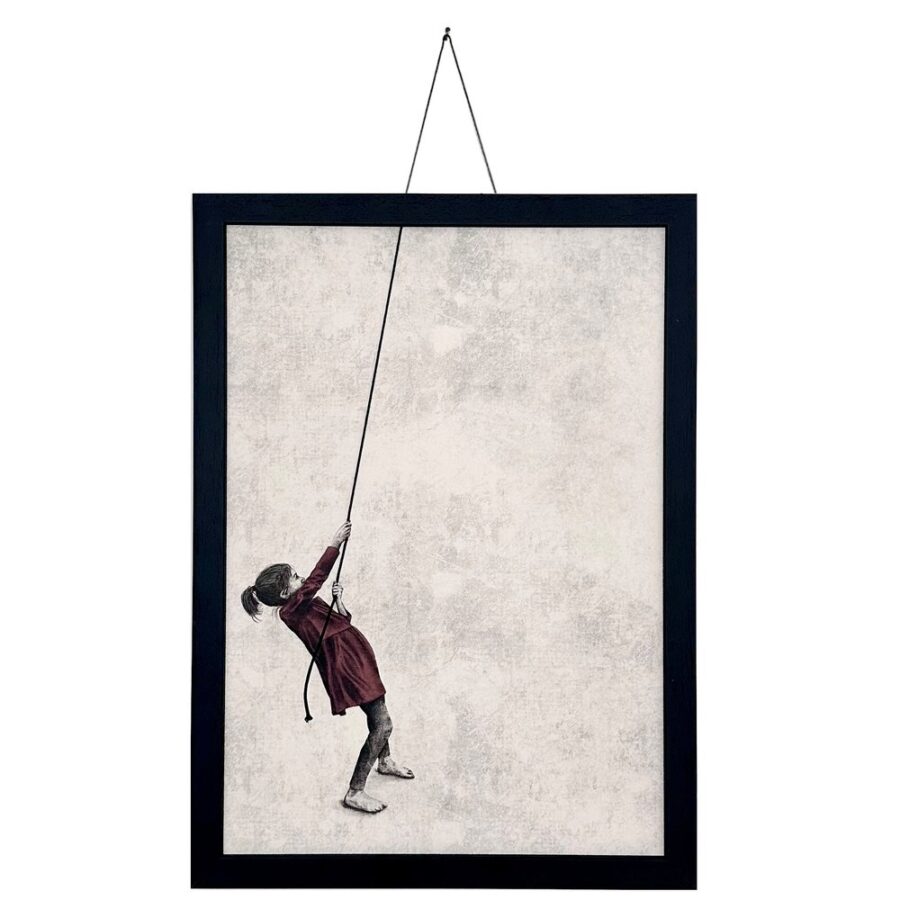The Unfolding Canvas of Contemporary Consciousness
Today’s society is exposed to an incessant stream of visual information, often awakening a longing for authenticity and depth. Amidst this deluge, Andrew Scott emerges as a remarkable figure who paradoxically utilizes digital platforms to draw attention to the tangible, often fractured, nature of the human experience. His artworks, characterized by a unique blend of illustration and installation, speak a universal language deeply rooted in the 21st-century cultural landscape.
Andrew Scott’s work positions itself within the broader cultural discourse surrounding mental health, self-reflection, and the search for meaning in an increasingly complex world. His works resonate profoundly, as they are not only aesthetically pleasing but also address universal human struggles and the pursuit of freedom. He succeeds in building a bridge between the personal and the collective by externalizing the inner landscapes of the mind.
With his distinctive “frame experiments” and profound thematic explorations, Andrew Scott not only challenges traditional artistic boundaries but also serves as a poignant mirror of the contemporary psyche. He invites viewers into a dialogue about identity, resilience, and the liberating act of breaking out. The immense popularity of his “frame experiments” on social media, garnering over a billion views on platforms like TikTok, Instagram, and Pinterest, is a fascinating phenomenon. However, this digital reach is not an end in itself. Rather, it serves as a powerful tool to generate curiosity and direct the audience towards the physical artwork. Andrew Scott understands that his art “cannot be flattened. It is personally better, more dangerous, more fragile, more sincere.” This suggests a new paradigm in the art viewing experience: digital virality becomes a gateway for deeper, tactile appreciation, rather than an endpoint. It is a transformation that allows global accessibility for the initial encounter with art, while simultaneously emphasizing the irreplaceable value of direct, personal experience of the art object.
The Genesis of the Break: Andrew Scott’s Artistic Origins and Signature
Andrew Scott’s artistic journey began in Rochester, New York, where he was born in 1991 and discovered his passion for art at a young age. His education at the Pratt Institute in New York City, where he studied illustration, formed the foundation for his later conceptual approach and allowed him to refine his skills and develop his distinctive style. This academic grounding in illustration is crucial to understanding his ability to convey complex narratives and emotional nuances in his works.
The “Broken Glass” technique, for which Andrew Scott is now known, originated from a childhood fascination with the way glass fragments. This early curiosity evolved into a distinctive contemporary art style. He uses various deliberate methods to break the glass – whether by hand, with a hammer, or a chisel. This is not random destruction, but a controlled, intentional act that forms the basis of his artistic statement. The deliberate fragmentation is a central element of his practice, elevating his works from mere illustrations to dynamic, sculptural objects.
Aesthetically, Andrew Scott’s approach is characterized by a minimalist environment dominated by a grayscale palette, punctuated by “selective red color accents.” This targeted use of color, often combined with gritty graphites, creates a distinctive and instantly recognizable signature. His works begin as hand-drawn digital illustrations, which are then printed on high-quality silk or watercolor paper. The crucial step, however, lies in the meticulous hand-finishing, where he employs various tools, processes, or materials such as burning, threading, and tearing to create the final, often sculptural form.
The conceptual depth of the “Broken Glass” technique as a metaphor extends far beyond mere aesthetics. Andrew Scott himself revealed that his “current frame modifications are a manifestation of his emotional state from all the years he had abandoned art and felt trapped in a job and a world that brought him no fulfillment.” He expresses it unequivocally: “Much like the characters in my frames, I finally broke out of the box that had closed in around me.” This statement elevates Andrew Scott’s “Broken Glass” technique from a mere technical innovation to a deeply personal and philosophical declaration. The act of breaking and altering frames is not just a visual disruption; it is a direct, tangible metaphor for his own journey of liberation from perceived constraints. This personal narrative imbues his works with authentic emotional resonance, making “destruction” a necessary precursor to “construction” and freedom, a theme with which viewers can universally identify.
Beyond the Canvas: The Fourth Wall and Conceptual Storytelling
Andrew Scott’s artworks transcend the traditional two-dimensional plane in a way that directly engages the viewer. His “conceptual frame modifications” and the use of broken glass elements are designed to break the “fourth wall.” The frame thus becomes an active, integral part of the artwork itself. This technique actively draws the viewer into the work, blurring the line between subject and observer and creating a dynamic sense of movement and tension. Figures appear to leap through shattered glass or interact with the frame, creating a surreal, almost dreamlike atmosphere.
His unique mode of communication is strongly inspired by the working methods of editorial illustrators and street artists. This manifests in his “visual plot twists, symbolic subversions, and conceptual storytelling.” Each artwork is not just an image, but a frozen narrative, often suggesting a “before” and “after” moment. This narrative gesture invites the viewer to decipher the story behind the visual representation and to engage with the emotions and actions depicted.
Andrew Scott skillfully uses the techniques of illusory perspective, shadows, and anatomical precision to simulate dimensionality and enhance the dramatic effect of his figures interacting with the broken frame. The limited color palette, often in stark black and white with occasional crimson details, heightens the drama and directs attention to the symbolic core of each piece. These conscious aesthetic decisions are not merely stylistic but serve to maximize the emotional and conceptual impact of his works.
Andrew Scott’s art goes beyond mere representation and becomes an interactive experience. His technique allows the viewer to “become part of the artwork,” and viewers are explicitly “invited to participate and contemplate.” Another aspect that enhances this interaction is Scott’s deliberate choice of “ambiguous titles [that] help the viewer come to their own conclusions.” This conscious invitation for viewer participation means that the meaning of the artwork is co-created at the moment of reception, making each interpretation unique and deeply personal. This approach fosters deeper engagement and transforms passive observers into active participants in the artistic narrative, fitting well with contemporary art movements that prioritize experiential and participatory art.
Echoes of the Psyche: Themes of Identity, Memory, and Transformation
Andrew Scott’s primary subject is the complexity of the human mind and mental health. His works explore both the “light and dark sides of our nature,” focusing on emotional growth and the full spectrum of human emotions – from hope, optimism, and joy to confusion, doubt, and fear. He creates a visual language that allows the viewer to engage with these often intimate and complex emotional states.
His art serves as a poignant reminder of our multifaceted emotional landscape. Andrew Scott aims to spark conversations about mental health, break down stigmas, and foster empathy by inviting viewers to embrace their vulnerabilities. His characters, often children at play or adults seeking escape, serve as accessible metaphors for universal human struggles. These depictions allow a broad audience to identify with the profound messages of his art, as they reflect the human experience in all its facets.
Recurring motifs in Andrew Scott’s work include escapism, loneliness, curiosity, empowerment, freedom, solitude, and resilience. The figures in his works, whether breaking out of frames or navigating challenging landscapes as in “The Escape,” symbolize the ongoing human struggle for self-realization and liberation from internal and external constraints. The concept of “transformation” is central: fragile materials become stable, and trapped figures find their way out.
Andrew Scott’s artistic practice extends beyond aesthetic creation; it functions as a form of social commentary and advocacy. His mission is to “explore the complexities of the human mind through his art” to “spark conversations about mental health, break down stigmas, and encourage people to seek help.” Andrew Scott himself stated that his art “is inspired by his own journey to break free from the things that trap him, and he hopes others can take away a similar message.” By openly addressing mental health and the universal desire for liberation, his art creates a safe and accessible space for viewers to engage with their own emotional landscapes. This makes his work not only visually captivating but also deeply empowering and potentially therapeutic, fostering a sense of shared human experience and encouraging a more open societal dialogue about vulnerability and resilience. Andrew Scott effectively uses art as a tool for collective self-reflection and healing.
From Screen to Gallery: Reception, Discourse, and Cultural Resonance
Andrew Scott’s unparalleled rise to prominence was largely fueled by his “viral frame experiments,” which garnered over a billion views on social media platforms like TikTok, Instagram, and Pinterest. This digital engagement led to tangible recognition within the traditional art world. His works have been exhibited in major galleries and museums worldwide, including the Museum of Modern Art in New York City and the Tate Modern in London, as well as in public spaces such as the World Trade Center atrium.
The critical reception of his work is overwhelmingly positive; it is often described as simple yet powerful, inspiring, thought-provoking, and emotional. This is also reflected in market trends, as the value of his works has increased significantly. An example of this is the work “Foul Ball,” whose value rose from £350 to £1000 in a short period. This indicates a strong and rapidly growing presence in the art market, appealing to both collectors and the wider public.
Andrew Scott’s influence also extends to collaborations with renowned brands such as Manchester City F.C. and the inclusion of his works in prominent collections of personalities like Joanna Gaines and Kaley. These collaborations and prominent acquisitions demonstrate his cross-cultural appeal and mainstream resonance, bridging the gap between fine art and popular culture.
Andrew Scott’s art speaks to a generation “obsessed with surfaces but aching for substance.” He uses the very platforms that often promote superficiality to convey profound messages. His work challenges the notion that art must be exclusive or inaccessible to be meaningful. Andrew Scott’s success illustrates a new model for artistic recognition and dissemination in the 21st century. His popularity shows how digital platforms can democratize access to art, bypassing traditional hierarchies and directly engaging a global audience. This virality, coupled with his accessible yet profound thematic content, recontextualizes art from an elitist pursuit to a widespread cultural phenomenon. This forces a re-evaluation of what constitutes “critical success” in contemporary art, suggesting that broad public resonance, enabled by digital means, is becoming as significant as traditional institutional validation.
An Evolving Horizon: Andrew Scott’s Trajectory in Contemporary Art
Andrew Scott’s impressive exhibition history includes presentations in major galleries and museums worldwide, including the Museum of Modern Art in New York City, the Tate Modern in London, and public spaces such as the World Trade Center atrium. His representation by the Stowe Gallery in London plays a crucial role in the global promotion of his works. Upcoming exhibitions such as “Frame of Mind” in July 2024 and “Parallel Worlds” from July 31 to August 12, 2025, in London attest to his continued relevance and presence in the international art scene.
Andrew Scott’s artistic development is a continuous process. Originally known for his “destruction-focused” frame ideas, he is now also exploring “construction” in his frame concepts. This evolution is reflected in works like “The Stairway,” which marks a transition from deconstruction to the creation of new forms. He also experiments with new variations of existing techniques, as seen in “Look,” an evolution of “Peer,” or in the works “Spray” and “Drip.” His shift towards ambiguous titles, as in “Pull,” also signals a desire for deeper engagement and interpretation by the viewer. These strategic changes in his practice, including stopping commissions to focus on other projects, underscore his commitment to artistic evolution.
Andrew Scott’s ability to combine profound psychological themes with innovative, accessible techniques positions him as a significant voice in contemporary art. His continuous exploration and refusal to rest on past successes suggest a promising development and lasting influence. Andrew Scott’s commitment to artistic growth and intellectual curiosity is evident. His evolution from primarily “breaking” to “constructing” frames suggests a more nuanced engagement with boundaries – not just their destruction, but also their redefinition and the potential for new forms. The deliberate use of ambiguous titles further empowers the viewer by shifting the artistic dialogue from a single message to a more open, collaborative interpretation. This positions Andrew Scott as a thoughtful and adaptable artist who continuously expands the boundaries of his own practice, thus ensuring his continued relevance and impact in the ever-changing landscape of contemporary art.
Andrew Scott’s artistic journey is a captivating testament to the enduring power of art to articulate the ineffable. His “frame experiments,” far from mere visual spectacle, serve as potent metaphors for the universal human desire to transcend limitations, both tangible and psychological. In a world grappling with the complexities of identity and mental well-being, Andrew Scott offers not only aesthetic pleasure but a profound invitation to self-reflection and liberation. His work reminds us that true artistic innovation often lies in the courage to shatter conventions, allowing new realities – and new understandings of ourselves – to emerge from the fragments. As Andrew Scott continues to evolve his unique visual language, he reaffirms art’s essential role as a catalyst for dialogue, empathy, and the eternal pursuit of freedom within the boundless canvas of the human mind.









